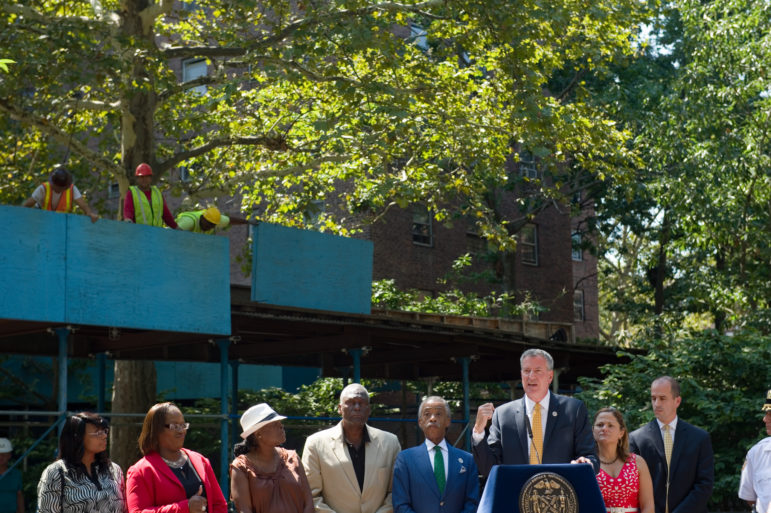
Rob Bennett/Mayoral Photography Office.
August 2014: Mayor Bill de Blasio hosts a press conference at Lincoln Houses in Manhattan to highlight steps the administration is taking to make NYCHA developments safer.
“We have a whole different presence in public housing,” the mayor said in February 2017. “And it’s growing, the neighborhood policing program is growing all the time, it’s getting to more and more precincts,” de Blasio said. “Since overall crime has continued to go down, and generally housing tracks that, I think were very well positioned to have a consistent decrease in crime in public housing, and we’re absolutely going to double down on things like the lighting, and the recreation programs, and all the things we think made a huge difference.”
Since then, additional cameras have been installed in NYCHA developments outside MAP, devices the mayor has called “vital” tools in decreasing crime in these neighborhoods.
But because crime in housing is going up overall, some NYCHA residents and advocates feel that without an exact roadmap for how these initiatives will be rolled out in all NYCHA developments, it is hard to feel included in the agenda that de Blasio, who is running for re-election this year, envisions for New York City.
Still at the scene of the crime
Castillo says she has not received a response to her February 2016 letter to the Bronx D.A.’s office.
“They used me,” Castillo says. “The promise was they were going to transfer me out. I did my part.” The Bronx D.A.’s office did not respond to multiple requests for comment.
Castillo still hopes for a transfer, more worried than ever about the safety of her children as crime climbs within NYCHA. She said she has needed counseling herself to cope with the trauma she has experienced in the last few years. Fortunately, associates of the shooter have not targeted or harassed her or her children since the incident, she says, though she and her oldest son have been mugged on separate occasions.
In November 2016, though, one of Castillo’s most-dreaded nightmares manifested, when her youngest son was graphically threatened with rape by a stranger who had gotten in the building, just as the then 13-year-old tried to come home from school, alone. “I know where you live now so you better not tell anyone,” the suspect allegedly told her son, Castillo recalled in a November 17, 2016, letter to Bronx D.A. Darcel Clark.
“This latest ordeal has affected my children and I significantly,” she wrote. “We do not feel safe in this borough, much less in this housing development.”
Though the perpetrator was later arrested and charged with endangering the welfare of a child, he was convicted only on a charge of public exposure and released on time served. Castillo says she was told by building management she would not qualify for transfer under the child sexual victim priority, because, she said she was told, her son wasn’t actually raped, a crime that would have qualified the family for transfer, according to NYCHA’s application for child sexual victim transfers. “Endangering the welfare of a child,” NYCHA rules stipulate, is not one of the crimes that qualifies a family for transfer.
Her son hasn’t been the same since, she says, especially since the perpetrator often frequents the area near her children’s school. The family remains at St. Mary’s Park Houses.
“My heart is broken, Castillo says. “The system cannot be that screwed up. I don’t believe it.”
Her kids have since given up on moving, Castillo says. “My son told me we should stay here,” she said. “He said ‘At least we know how to dodge the bullets here.'”
This article was supported by an Ida B. Wells Fellowship from The Investigative Fund at The Nation Institute.









One thought on “NYCHA Crime Witnesses Face Obstacles When They Seek Safety”
I have a son, & daughter-in-law, & numerous friends who work for NYCHA. I have observed from up-close the dangers, & hazards facing NYCHA employees DAILY, yet now, you expect them to continue to do the work with less resources, ARE YOU SERIOUS!!! NYCHA ranks right next to the Department of Sanitation as one of the dirtiest jobs, what with having to deal with vermin, (live & dead), vomit, feces, (of both the animal & human kind), toxic waste, filthy areas where they eat, having to enter into apartments that one would have to see to believe that tenants live in, drugs, etc. It is inhumane for both tenant & workers!!! As if that weren’t enough. we now have Mr. Ben Carson, who has been appointed to head NYCHA, who has absolutely “NO EXPERIENCE”, calling the shots. It’s demoralizing for the workers & adds “insult to injury”!!
Just picture for a moment, city without Sanitation, or, NYCHA to clean your filthy buildings?!! Let’s not forget that you are knowingly allowing tenants, calling special attention to children & animals, to live in inhumane conditions, allowing poor responses for repairs for months, while allowing politicians to lobby for gentrification, while tenants languish in filthy conditions. You are using re-zoning to displace hundreds, so, that you can sell them to the wealthy, who will receive all the financial assistance & convert these same filthy dwellings into beautifully restored apartments, complete with new trees, & playgrounds. Those poor living there currently apparently are not worthy of such treatment. You all forget, that God is watching & He Will Make It Right for All His Children!!